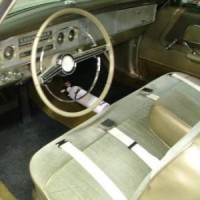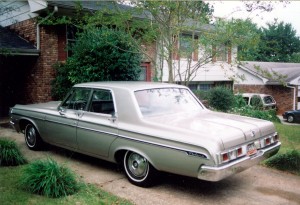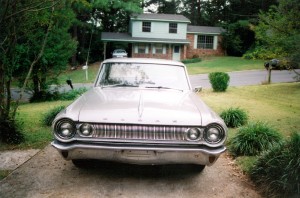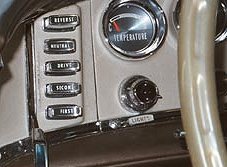Vent Windows, Spare Tires (1995)

©1995, 2013 by Dallas Denny
Source: Denny, Dallas. (1995). Vent windows, spare tires: Why I drive a classic automobile. Unpublished essay.
About the Thumbnail Photo: I have no shots of my 1964 Dodge Polara’s interior, so I found this one on the internet. My car was identical (also gold-colored), with two exceptions—there were no seat belts (they were not required in 1964) and there was an air conditioning unit under the dash on the passenger side. But close enough. Photos of my car follow in the text.
Vent Windows, Spare Tires:
Why I Drive a Classic Automobile
By Dallas Denny
I live in Atlanta, a town filled with Yuppie lawyer scum who fill the freeways with Porsches and Beemers and Jaguars and Mercedes and Lexuses and Nexuses and Infinitis and other cars that cost more than people in some parts of the country pay for their houses. They have a right to drive such flashy trash, I suppose, as much as any of us have a right to burn irreplaceable fossil fuel, support manufacturers who release toxic metals into the water table, and fuel an economy which makes no sense. Yes, I suppose they have a right to take Buffy to her dancing lessons, but I don’t like them and I don’t like their cars, which seem to be getting uglier as the years march on.
When my 1979 Mercury Monarch died secondary to damage suffered when I was foolish enough to drive it in a hurricane, I refused (it was a form of rebellion) to buy a foreign-made, late-model, computer-controlled model with incomprehensibly complex mechanical components and infuriating safety features like warning lights and buzzers and a transmission which won’t go into gear unless you are stepping on the brake. Instead, I went retro. I bought a 1964 Dodge Polara.
The Dodge is Detroit iron, a holdover from an age when seat belts and a thin covering of fabric over a metal dash were considered the latest word in passenger protection, and gas was twenty-three nine a gallon. Driving it has made me aware of how much things have changed and how little things have changed in the nearly forty years which have elapsed since it was assembled by highly paid, poorly-motivated Chrysler employees.
Like the most innovative and expensive new models, the Polara has four wheels, a trunk, a motor, automatic transmission (mine has push buttons!), speedometer, heater, air conditioner (it works even after 35 years!), a steering wheel, a radio (AM, with CONELRAD triangles), windshield wipers, headlights, safety glass in the windshield, and pedals to push to make it stop and make it go. Unlike the new cars, it doesn’t have a PCV valve, fuel injection, oxygen sensor, on-board computer, levers to pull to open the fuel compartment, trunk, and hood, electronic ignition, catalytic converter, shoulder harnesses, air bags, rear window defogger, electric windows, automatic door locks, or an antenna which goes up and down when the radio is turned on and off.
The Dodge does, however, have a lot of things which the new models don’t have, and which they are the worse off for not having:
Vent Windows
I’m not a fan of capital punishment, as it tends to be more expensive than incarceration and executes a disproportionate number of poor black criminals instead of the rich yuppie lawyer and celebrity ex-football star rabble I would prefer to see fewer of, but if I can think of one person who I would like to have in the hot seat when the switch it thrown, it’s the individual who made the hairbrained decision to do away with vent windows. Flow-through ventilation, which doesn’t, has turned vehicles without air conditioners into hotboxes, so that most must and do have air. This has contributed significantly to the release of flourocarbons into the atmosphere. These are the little buggers that are responsible for the destruction of the ozone layer and why you really should go see the doctor about that sore on your upper lip that doesn’t seem to be healing.
Vent windows require no electricity. When it’s merely warm outside, they make the inside of the car pleasant, and when it’s hot, they make it bearable. They save fuel by making it comfortable to keep the air conditioning off except on the very hottest days. And they waft away the cigarette smoke of your cousin Nick there on the front seat beside you, and give thieves an alternative to breaking the bigger window when they want your radio. In the Polara, I can maintain comfort while minimizing risk of carjacking by cruising along with only the vent windows open. Besides, they’re like a sign that says “My car is old, and therefore cool.”
Simplicity
When something goes wrong with the Polara, it isn’t difficult to figure out what it is, or expensive to repair it (provided parts are available— I admit this is could be problem for a car which is more than three decades old, although it shouldn’t be, since most of the ’64 Polaras are quietly rusting in automobile graveyards with perfectly good heater switches and windshield wiper motors and rear axles). There are no components which sound suspiciously like the mechanic is making them up: “Uh, the servo relay which operates the anti-static component of the computer which controls your electronic ignition needs replacing. It’ll be four hundred bucks—if we can locate the part.” The ignition system consists of a coil, distributor, cap, and points ($19.95, $39.95, $14.95, and $5.95, respectively, at Pep Boys), which I can put on myself, if I feel like getting my hands dirty, or can have replaced for about twenty bucks by my mechanic, who loves to work on an automobile which has as its basic function transportation and not protection of its driver from her own stupidity.
Spare Tire
You remember your spare, don’t you? It was that round thing that lay in your trunk until one of your tires went flat, and you put it on and drove away with dignity. Now spares are half-size, high-tech devices which are more trouble to use than they’re worth. It’s simpler, really, to call AAA on the cell phone and sip coffee at the Waffle House on the corner until your car is ready— if you happen to break down in the city. Have a flat some Sunday night on the interstate halfway between Oklahoma City and Amarillo, and it’s another story altogether: “Now where is that little can to inflate this thing? There it is. Do I blow it up now, or after the spare is on the car? Before, I guess. So why aren’t I hearing a hissing noise? Damn! I thought the can felt awfully light!” Oh. A little bird just told me the blow-up spares are a thing of the past. Instead, there’s a tricycle wheel that will take you only about 25 miles at 25 miles an hour before it shreds into confetti and leaves you stranded once again.
Bumpers
Bumpers— remember them? They were metal things on the front and back of your car which protected the body from damage when you ran into shopping carts in the parking lot at the supermarket and when the man in the car behind you slammed into you at the traffic light because he was trying to tune in the ball game on the radio and wasn’t paying attention. Bumpers went away in the ’60s, and came back for a while in the late seventies, and then were gone again; they’re the automobile industry’s equivalent of hemlines. Now there are no bumpers, just plastic extensions on the fronts and backs of cars which theoretically allow them to careen off of obstacles like other cars and Department of Transportation barricades without doing too much damage to your vehicle. In reality, they translate into several thousands of dollars of damage for the slightest bumps, skyrocketing insurance costs, and makes huge profits for the auto body repair industry, which thinks bumpers should be illegal.
Well, to the chagrin of insurance agents everywhere, the Polara has bumpers. Bumpers from hell. They make me feel as if I’m driving a tank. They make me sneer at Lexuses and Acuras and tempt me to slam on my brakes hard when drivers of Porsches act superior in traffic and somehow wind up too close behind me. Yuppies, even those in those overbearing sports utility vehicles, keep well away when they see a madwoman in two tons of vintage Detroit iron bearing down on them.
Convenience
For the most part, it’s convenient to drive the Polara. There are no flashing lights, bells, or buzzers when I turn on the ignition, or when I turn it off. The car will go into gear without the ignition key being in place, and without my foot on the brake, which is convenient when I run out of gas at a traffic light and have to push it backwards into the parking lot of the Jiffy Lube (Fuel efficient, it isn’t). The steering wheel turns freely whether the ignition key is in or out. And the key inserts in the dash instead of the steering wheel, which is pretty handy at two AM on Saturday morning after a pitcher or two at the local pub, when you’re ready to drive home—something, which, by the way, it was considered perfectly acceptable to do back in 1964.
The Polara is convenient in other ways, as well. It has a big old 318-cubic-inch V-8 engine with 230 horsepower and loads of torque. Both the front and back seats will hold three people in reasonable comfort. The trunk is as big as some Eastern Seaboard states. The engine, big as it is, looks like a marble in a shoebox; there’s plenty of room to work on things under the hood. And the hood has counterweights, which makes it go up and down with ease. There’s no need to prop it up with a rod. The metal of the hood and trunk, and for that matter, the roof, is thick enough to sit on without denting the bodywork. And of course, there’s the fact that it’s a car and not an investment, so the world doesn’t come to an end if it acquires a dent or scratch during daily driving.
If my car were even older, from the days when car owners were motorists and not drivers, it would have even more neat things: a rumble seat, perhaps, or running boards. Unfortunately, I’m not rich enough to be more than 35 years retro. I’m stuck in the sixties, antique-wise.
If car manufacturers were as smart as they think they are, they would re-introduce features like vent windows and full-size spare tires. Apparently, some are rethinking such things. I recently rode in a brand new Toyota Camry with the keyhole in the dash, and I saw a late-model Japanese prestige model with vent windows.
Perhaps I can be a value-added retailer, and market my Polara to the Lexus and Acura and Infiniti set. After all, they’re too dumb to realize that they’re really driving Toyotas and Datsuns and Hondas. I can see the ad now:
Now available (one only). Super-prestige model with vent windows, counter-weight hood, push button automatic transmission, full-size spare tire, roomy interior, low maintenance 16-valve engine, factory air, and low-impact collision protection. Only $36,000; will consider trade for late-model Lexus or Acura.







